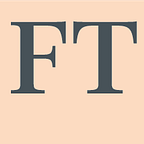How we calculate the Next Best Action for FT readers
By George Kastrinakis
As part of a wider attempt to provide a more personalised and relevant experience to FT readers, we developed an NBA model. This model attempts to make our communication with our readers more efficient, while also allowing them to make the most out of their subscription.
What is an NBA model?
A Next Best Action (NBA)model can be implemented in any business that offers more than just a single product. NBA models can rank various products on a customer or wider level given an objective function.
The objective function needs to represent the expected impact of each action towards an end goal.
The end goal can be any business metric that is widely accepted as a measure of success.
An example for the FT could be the following: a reader signing up to a newsletter (action) is expected to increase reader engagement (end goal) by 0.1, whereas starting to use the FT mobile app by 0.12. So, for that specific reader, using the mobile app will appear higher in the ranking.
Our hypothesis is that we can increase reader engagement (end goal) by suggesting actions that they are more likely to take and are also highly correlated with reader engagement (objective function).
Why do we need one at the FT?
At the FT, there is a great variety of products that can support and complement the content available and improve user experience. The challenge is to surface all of the relevant products to the readers without overwhelming them with too many communications. The NBA model allows us to prioritize and potentially limit product promotions based on each reader’s needs.
What does an NBA model look like for the FT?
The products available at the FT, allow readers to personalise their experience while onsite, access FT content from a mobile device, get instant alerts and push notifications or subscribe to newsletters for their favourite topics.
A big part of our work for the NBA model involved extensive research for these products and more specifically investigating correlations between them and reader engagement.
It is worth emphasizing here that we are not trying to find causation, but just identifying reader habits that are more frequent with engaged readers.
The end goal for our NBA model is increased reader engagement and the objective function consists of two distinct components, the product value and the product likelihood.
Product value is a measure of the expected product impact on reader engagement. Product value should answer the question, “How will reader engagement change if they start interacting with product A?”. Product values are calculated on a user-base level, so we have a single value per product on a given point in time. We re-calculate and update product values every month to make sure we adapt change in the behaviour of our readers.
Product likelihood is the probability that a reader is going to start interacting with a given product. This is calculated separately for each reader on a daily basis and takes values from 0 to 1. In order to do that we trained a model for each product that takes features from the past 90 days and predicts interaction over the following 4 weeks. Features used to make the predictions are other products available and reader interactions with them alongside recent reader engagement.
Finally, we apply predefined weights to both components and combine them in order to get a ranking of all products for each reader.
The figure that we use for the ranking is called relative value and is specific to every reader, their existing habits and engagement.
We have also implemented a re-suggestion filter to avoid promoting products that the reader has recently interacted with. This filter identifies interactions with products over a 90 days period and automatically removes them from the calculations.
Testing the model
We will be analysing the data from our initial A-B test over the next weeks and are now getting ready to launch a second one. The test results will give us an indication of which parts of our model are performing and where we should be focusing more next year.
The Next Best Action model, is an initiative from Envoy, an internally built decisioning engine and the Data Science team.
Originally published at https://medium.com.
